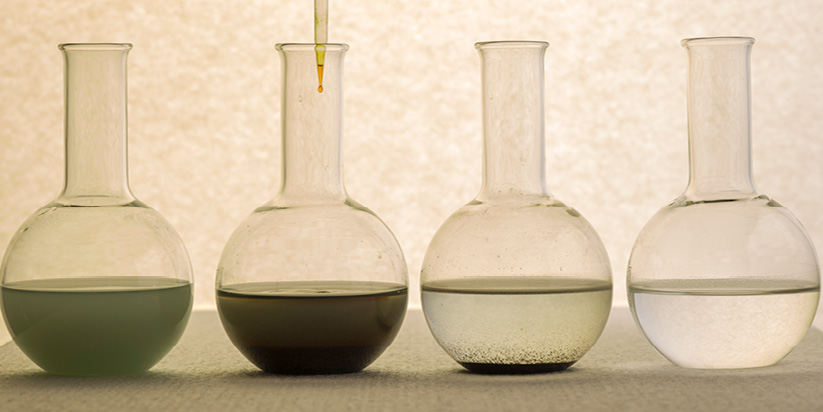Partial heavy metals precipitation can be achiseved sulphidically in acidic waste water. Further sulphide precipitation is achieved by increasing the pH-value, i.e. after neutralisation. For this purpose, precipitating and neutralizing agents must be added to the water.
The residual metal content in the water after precipitation determines which type of precipitation should be used. The precipitation process do not run to completion, as is the case with most chemical reactions. Even after a precipitation carried out under optimal conditions, small amounts of the dissolved metal remain in the water.
Here the sulphidic precipitation shows its enormous advantage over the hydroxide precipitation. The residual metal values are several order of magnitude more effective (10,000 to 10 million times lower). This difference, determined for ideal water, also applies for real solutions. In the latter case of waste water solutions contaminated with salts and organic substances, the residual solubility of the heavy metals increases significantly according to the laws of chemical thermodynamics.
The newer discharge values (legally prescribed residual metal contents) can no longer be guaranteed with hydroxide precipitation.
Despite its enormous advantages and popularity, sulphide precipitation has not been able to establish itself to this day. On the one hand, the danger of releasing hydrogen sulphide gas, which arises during the sulphidic treatment of acidic waste water, is so great that it cannot be reliably contained even with considerable effort in apparatus, measuring and control technology.
Hydrogen sulphide is also toxic, comparable to hydrogen cyanide. In addition, the also toxic sulphides also remain in the purified water.
PreciPAN® – – means and processes, realizes sulphidic precipitation with its enormous advantages and without the above mentioned. serious disadvantages. The polysulfide nature of the agent guards against the release of hydrogen sulphide during the waste water treatment process.
Excessively high doses of PreciPAN® should not present problems as the residues of precipitants decompose into harmless sludge during precipitation and other treatment – also due to the chemical system.
Most heavy metals are present in wastewater as mono-, di- or trivalent cations and can thus be precipitated with relative ease. However, there are metals such as chromate and vanadate, which are polyvalent and anionic and are not accessible to precipitation. They are reduced with PreciPAN® in the acid medium and then precipitated.
PreciPAN® also eliminates a number of the usual anionic pollutants such as cyanide, nitrite, sulphite or free chlorine, e. g. sulfite to sulphate, cyanide to rhodanide (and then precipitate). The same applies to fluoride, silicofluoride, oxalate, citrate, tartrate, phenolates, fatty acids and other ionogenic surfactants. Weak acids and other anionogenic substances, including complexing agents, are protonated and thus their binding to the medium water is destabilised. Emulsions are split, oils and fats are released.
The released lipohil substances are readily adsorbed on the also hydrophobic, sulphidic precipitate and thus removed from the water into the sludge. All colloidal systems, amphoteric substances, proteins, oligomeric brines, as they are often used in modern technologies and can reach their isoelectric point by gradually increasing the pH value and thus can be excrtracted. In laboratory tests (treatment of various waste water with PreciPAN®) such turbidity and flocculation can be observed more often during the course of the pH increase.
All of the effects described above are ultimately reflected in a general pre-treatment of the waste water. The treatment process is based on the type of waste water and is first determined in the laboratory; subsequently the process is optimised in pilot tests in the laboratory and/or in the large-scale plant trials.
The investigation of an unknown waste watersample is started with the standard method. If the water is not already acidic the pHis adjusted to 4 with a little hydrochloric acid and add a small amount of diluted PreciPAN® solution (PTL). Cloudy, mostly black precipitation forms, which flocculates after a short time. By adding further drops of PTL, it can be determined whether the precipitation (at pH 4) is complete. If the precipitation is complete the pH can be increased with lime milk to approx. 6 and drip addition PTL is repeated. The sample is then neutralized with lime milk to pH = 8. After the newly formed precipitation is flocculated, the water is filtered and determined by acidification and addition of PTL whether the precipitation agent has been sufficiently dosed, under- or overdosed.
A large part of the waste water types can be investigated and treated using this simple method. However, there are exceptions with complexing agents, high salt content, solutions contaminated with surfactants, buffers, etc. In these problematic waste waters, which are considered untreatable, PreciPAN® still offers the possibility of removing heavy metals in accordance with the law by developing special strategies, but for the development of a suitable process, it is necessary to carry out weeks of application research, sometimes even basic research.
PreciPAN®, means and processes, has been successfully tested in more than 100 plants from almost all branches of industry.
- The above mentioned Advantages of sulphidic precipitation were confirmed, in some cases exceeded.
- High separating effect (heavy metal from waste water).
- Selective separation, e. g. copper and nickel.
- Clear, clean water and compact, well-settled and filterable sludge. The amount of sludge amounts to about 1/3 to 1/5 of the hydroxide produced sludge, with the same starting material.
- Despite the excess precipitant used, no residual sulphide was detected in the treated water (residual sulphide less than 0.1 mg S2-).
- Elimination of cyanide, nitrite, fluoride, sulphite and free chlorine. Separation of surfactants and oils. Considerable reduction of the COD value.
- flocculation aids, electroflotation plants, lamella separators, gravel filters, etc. become superfluous.
- Excellent suitability for continuous flow systems.

